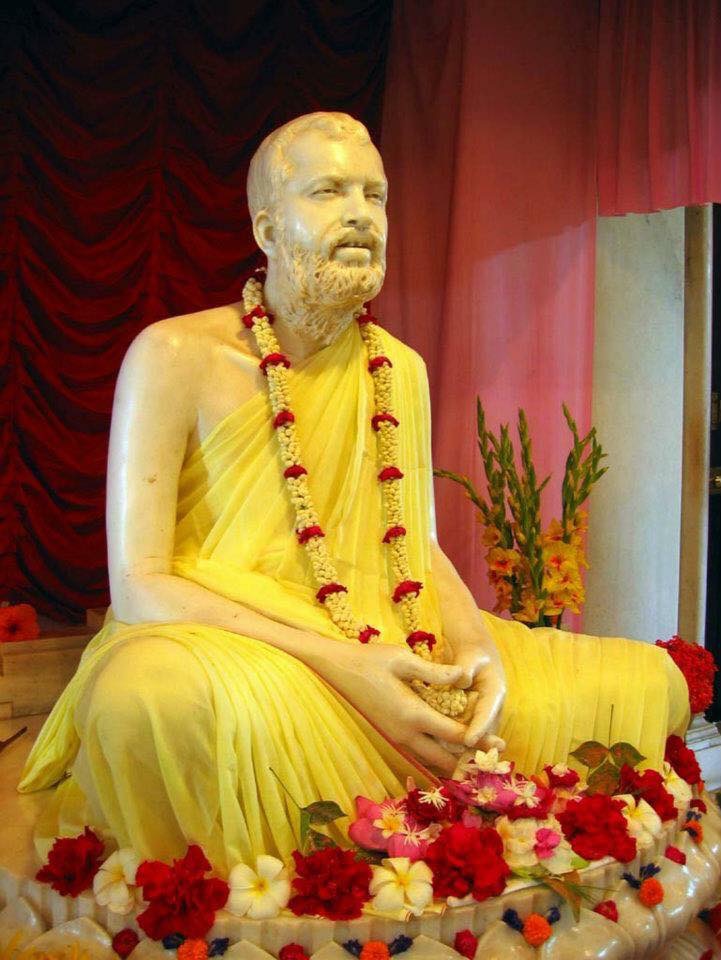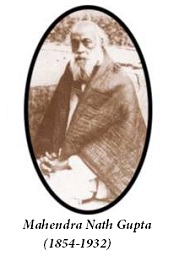Teachers from schools and colleges in and around Boston often bring their students to the Vedanta Society on field trips. What occurs during such visits has now become for me a familiar routine. Typically I welcome the group, give them an introductory talk on Vedanta, answer their questions, tell them about the programs offered at the Ashrama, and give them a tour of the place. Sometimes, seeing a picture of Ramakrishna in the room and even before I have had a chance to tell them about him, a student might suddenly point his finger at the picture and ask, ‘Who is he?’

In my earlier years in Boston, this question was jarring to my ears and the fingerpointing was mildly irritating. The question and the gesture no longer irritate me, maybe because I am now older and hopefully more mature. I now feel that strangers are not the only ones who should be asking that question. I should be asking it as well. Students of Ramakrishna’s life and even his devotees may have to ask the same question: Who is he?
Similar questions have been asked in the past. Going as far back as the Vedas, we find this question: ‘Who is this Being to whom we make these offerings?’ (Rig-veda, 10.121). Questions like these helped the early spiritual seekers probe deeper into the nature of reality and discover the infinite Being seemingly hidden behind the finite material world. A devotee of Ramakrishna may want to ask: ‘Is the Ramakrishna that appears to me the real Ramakrishna?’
Every great teacher lives in two dimensions: the spiritual and the historical. The spiritual dimension is beyond time, the historical is within the domain of time. When we look at the Ramakrishna of history, it is possible to think of him in terms of the past and the present.
Ramakrishna of the Past
Ramakrishna of the past is separated from us by both space and time. The only way to meet him is through books—and there are plenty of them, written and translated in most major languages of the world. The two foundational texts to meet Ramakrishna of the past are his biography written by his disciple Swami Saradananda and the record of his conversations kept by his disciple Mahendra Nath Gupta (better known as simply ‘M’). Reminiscences of Ramakrishna can be found also in the books written by and about his other disciples. Based on the information from all these books, movies and TV serials have been produced, songs have been written, and works of art have been created. All of these avenues make Ramakrishna of the past accessible to us.
We know that Ramakrishna was born in 1836 and spent his childhood in Kamarpukur before moving to Kolkata and worshiping at the Kali Temple in Dakshineswar. We read about his intense spiritual yearning, his first vision of the Divine Mother, his spiritual practices under the guidance of teachers from various traditions, his mystical visions, his pilgrimage to Benares and Vrindaban, the arrival of his disciples, the formation of the spiritual community around him, and his passing in 1886.
Ramakrishna’s profound teachings regarding the goal of life and how to attain it make us question our existing assumptions. His affirmation of the harmony of religions and the divinity of the human soul shakes us out of our unconscious biases and prejudices. Even a chance reading of a book about Ramakrishna has opened up for many amongst us a whole new way of understanding the world and our place in it. Ramakrishna of the past educates us, broadens our intellectual horizon, and strengthens our emotional well-being.
Nevertheless, he is still a distant figure. We can think about him but we cannot see him. His conversations are captivating—we can read the words and but we cannot hear him. Even his words are now more than a hundred years old, spoken to a group of people about whom we know very little. They heard him there at that time—while we are left stranded here at this time. Even as we feel close to Ramakrishna, time and space keep him way beyond our reach.
It’s a span that seems impossible to bridge unless a way can be found to bring the Ramakrishna of the past into the present. Luckily such a way exists.
Ramakrishna of the Present
Earnest students of Ramakrishna’s life have found a way to connect with him. Ramakrishna of the past effortlessly moves into the present when we make an effort to live according to his teachings. To understand what he said is one thing, but to live according to that understanding is quite another. It is the ‘living’ of Ramakrishna’s teachings that brings him into the present.
We experience deep inner peace and fulfillment when we practice his teachings about the primacy of God in life, the channeling of emotions in the direction of God, the harmony of religious paths, seeing God in all and serving them, and the value of not clinging to the constantly changing, crumbling material world. Memory belongs to the past, but experience always occurs in the present. When the effects of practicing Ramakrishna’s teachings are experienced, Ramakrishna of the past effortlessly moves into the present. His teachings are no longer simply words or ideas that emerge from them. His teachings become somehow more real—making him, in turn, a reality that is not as distant as it appeared earlier.
Modifying the way of studying Ramakrishna’s books can also help us bridge the gap between the past and the present. When we read an account of his conversation in Dakshineswar, for instance, we can either see it as a historical narrative or a personal encounter. As a historical narrative, we are merely reading about what Ramakrishna told a group of people sitting around him more than a century ago. With some amount of creative imagination, it is possible for me the reader to insert myself in that crowd. This produces a radical change in how the scene unfolds. Ramakrishna is no longer in the past speaking to them; he magically moves into the present speaking to me! This kind of study is potentially more transformative than doing it the old-fashioned way.
The power of Ramakrishna’s life and teachings becomes manifest not only in the lives of individuals but also through organizations that derive their inspiration from him. The enormous work being done through the worldwide branches of the Ramakrishna Order, for instance, is a standing testimony to Ramakrishna’s power active in a world which no longer has his physical presence. The sick are treated, the hunger are nourished, the grieving are consoled, the homeless are sheltered, and the lost are given a new hope—none of this is possible merely through an organizational structure unless it is animated with a higher power. The power of Ramakrishna operating in the contemporary world brings him from the past into the present. He is not gone, he still is. His power is with us and amongst us.
While Ramakrishna’s power can be felt and its tangible effects perceived, Ramakrishna himself somehow still feels out of reach. His presence can be sensed but not seen. The faithful know that he is present, but it is their faith that makes that kind of knowledge possible. Ramakrishna of the present is closer to us than Ramakrishna of the past, but not close enough. In order to see him, he and I need to come even closer. Is that even possible?
Ramakrishna of the Now
Thinking of Ramakrishna is an enriching experience and sensing his power operating in the world and in one’s own life is even more rewarding. But nothing comes anywhere close to actually seeing him directly. The Ramakrishna of history cannot really be seen. The Ramakrishna of the past can be known, the Ramakrishna of the present can be sensed, but it is only the Ramakrishna of the heart who can be seen. The Ramakrishna of the heart belongs to the spiritual dimension and transcends both time and space. He is here always. He does not belong to the past, not even to the generic present. He belongs to the immediate present. He is the Ramakrishna of the now.
To see the Ramakrishna of the heart, we have to obviously go to the heart. It is not the physiological heart that we go to. There is hardly any space in there to accommodate him. We don’t even go to the other heart which is the seat of emotions. It is true that Ramakrishna’s presence can become quite vivid in that heart, but it is far from stable. Emotions are like tides—they have their highs and their lows. They come and they go. They don’t have enough staying power. The Ramakrishna of the emotional heart plays hide and seek with us. To see Ramakrishna fully and permanently, we need to go to the spiritual heart, the heart which is the home of the Divine.
Finding the spiritual heart can take time. The Upanishads speak of the spiritual heart as a cave, deep and inaccessible, where the spirit manifests in a special way. A pure heart and a persevering mind with infinite patience are the only companions that can guide the search for this cave of the heart. Once it is located, it becomes easier to find Ramakrishna there. This happens in the state of deep meditation.
When we encounter Ramakrishna in meditation, we don’t think about him anymore, we simply see him. We are not even conscious of his power. When we are in his presence, he is all that remains in our consciousness. Even the idea that ‘I am seeing him’ is not present. The ‘I’ has to vacate the heart in order for Ramakrishna to be revealed. Time comes to a stop. Space is nowhere to be seen. With time and space gone, ‘seeing’ is all that remains.
Ramakrishna of the past educates us, Ramakrishna of the present inspires us, but it is only the Ramakrishna of the heart who can free us forever from samsara, the seemingly unending cycle of birth and death. All the three Ramakrishnas are connected, usually in a chronological order. Ramakrishna of the past leads us to Ramakrishna of the present who, in turn, leads us to Ramakrishna of the heart. When that happens, the spiritual life of a Ramakrishna devotee reaches its culmination and fulfillment.
Source : Vedanta Kesari, March, 2019

